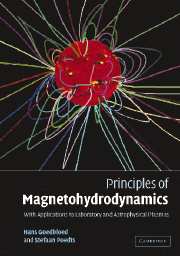Book contents
- Frontmatter
- Contents
- Preface
- Part I Plasma physics preliminaries
- Part II Basic magnetohydrodynamics
- 4 The MHD model
- 5 Waves and characteristics
- 6 Spectral theory
- 7 Waves and instabilities of inhomogeneous plasmas
- 8 Magnetic structures and dynamics
- 9 Cylindrical plasmas
- 10 Initial value problem and wave damping
- 11 Resonant absorption and wave heating
- Appendices
- References
- Index
11 - Resonant absorption and wave heating
Published online by Cambridge University Press: 22 February 2010
- Frontmatter
- Contents
- Preface
- Part I Plasma physics preliminaries
- Part II Basic magnetohydrodynamics
- 4 The MHD model
- 5 Waves and characteristics
- 6 Spectral theory
- 7 Waves and instabilities of inhomogeneous plasmas
- 8 Magnetic structures and dynamics
- 9 Cylindrical plasmas
- 10 Initial value problem and wave damping
- 11 Resonant absorption and wave heating
- Appendices
- References
- Index
Summary
In Chapters 7 and 9, the MHD spectral analysis of an ideal plasma with inhomogeneities in one spatial direction led to singular second order differential equations for the plasma displacement in the direction of inhomogeneity: Eqs. (7.91) and (9.31). The two singularities of these equations give rise to two continuous parts of the MHD spectrum, as demonstrated in Section 7.4 for slab geometry and in Section 9.2.2 for cylindrical geometry. It was shown that the eigenfunctions corresponding to these Alfvén and slow magneto-sonic continua possess non-square integrable tangential components leading to extreme anisotropic behaviour. Clearly, this has a dramatic effect on the dynamical behaviour of inhomogeneous plasmas. In the present chapter, we will discuss the consequences of these continuous spectra for the dynamical response of an inhomogeneous plasma slab or cylinder to periodic, multi-periodic, or random external drivers. This will lead to the concepts of resonant absorption of waves and phase mixing of neighbouring magnetic field lines.
Resonant ‘absorption’ (or ‘dissipation’) and phase mixing are fundamental properties of MHD waves that are studied in many different plasma systems. These phenomena affect the dynamics of plasma perturbations significantly and often dominate the energy conversion and transport in inhomogeneous plasmas. Since they are basic to MHD wave heating and acceleration of plasmas, they deserve special attention. In fact, since all plasmas occurring in nature are – to a higher or lower degree – inhomogeneous and since waves can be excited easily in plasmas, resonant absorption and phase mixing frequently occur.
- Type
- Chapter
- Information
- Principles of MagnetohydrodynamicsWith Applications to Laboratory and Astrophysical Plasmas, pp. 533 - 576Publisher: Cambridge University PressPrint publication year: 2004



